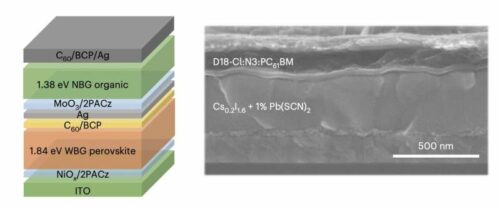This method achieves good results by suppressing phase segregation with a novel pseudo-triple-halide alloy, paving the way for durable and high-efficiency photovoltaics in the quest for sustainable energy solutions.

In the quest for efficient and affordable solar energy solutions, researchers have focused on organic solar cells utilizing perovskite materials. Compared to traditional silicon-based cells, these organic counterparts offer cost advantages, flexibility, and tunability. Despite achieving a certified power conversion efficiency (PCE) of 19.4%, lower than silicon cells, they hold promise for widespread deployment.
Researchers at Soochow University’s Suzhou Key Laboratory of Novel Semiconductor-optoelectronic Materials and Devices propose a breakthrough strategy to enhance the efficiency and stability of perovskite/organic tandem solar cells. Published in Nature Energy, their method addresses a critical issue known as phase segregation, which hampers the performance of wide-bandgap perovskite cells.
The team successfully suppressed phase segregation by introducing a pseudo-triple-halide alloy into mixed halide perovskites, incorporating iodine, bromine, and pseudo-halogen thiocyanate (SCN) ions. This innovation prevents halide elements from separating within the solar cells, improving crystallization and reducing grain boundaries.
The addition of SCN ions slows crystallization, preventing ion migration and facilitating electric charge movement within the solar cell. These ions enter the perovskite lattice, forming an alloy and occupying iodine vacancies, thereby blocking halide ion migration through steric hindrance.
The researchers achieved good results by testing their strategy on perovskite/organic tandem solar cells. The tandem cells exhibited a PCE of 25.82%, a certified PCE of 25.06%, and operational stability lasting 1,000 hours. This success underscores the potential of their methodology to advance the development of stable, high-efficiency perovskite/organic photovoltaics.
Looking ahead, the team claims that their research could be adapted to various wide-bandgap perovskite compositions, further enhancing the performance and longevity of solar cells. Ultimately, these advancements may lead to the realization of durable photovoltaic systems operating efficiently under diverse lighting conditions, heralding a new era of sustainable energy generation.
The post Enhancing Efficiency Of Perovskite Solar Cells appeared first on Electronics For You.
View more at https://www.electronicsforu.com/news/enhancing-efficiency-of-perovskite-solar-cells.
Credit- EFY. Distributed by Department of EEE, ADBU: https://tinyurl.com/eee-adbu
Curated by Jesif Ahmed